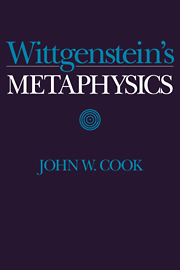Book contents
- Frontmatter
- Contents
- Preface
- List of Abbreviations
- Introduction
- Part I From Idealism to Pure Realism
- 1 Wittgenstein's Philosophical Beginnings
- 2 Neutral Monism
- 3 The ‘Objects’ of the Tractatus
- 4 The Essence of the World Can Be Shown But Not Said
- 5 What the Solipsist Means is Quite Correct
- 6 Pure Realism and The Elimination of Private Objects
- Part II The Metaphysics of Wittgenstein's Later Philosophy
- Part III Causation and Science in a Phenomenal World
- Part IV Logical Possibilities and the Possibility of Knowledge
- Part V The Past, Memory, and The Private Language Argument
- Name Index
- Subject Index
4 - The Essence of the World Can Be Shown But Not Said
Published online by Cambridge University Press: 05 November 2011
- Frontmatter
- Contents
- Preface
- List of Abbreviations
- Introduction
- Part I From Idealism to Pure Realism
- 1 Wittgenstein's Philosophical Beginnings
- 2 Neutral Monism
- 3 The ‘Objects’ of the Tractatus
- 4 The Essence of the World Can Be Shown But Not Said
- 5 What the Solipsist Means is Quite Correct
- 6 Pure Realism and The Elimination of Private Objects
- Part II The Metaphysics of Wittgenstein's Later Philosophy
- Part III Causation and Science in a Phenomenal World
- Part IV Logical Possibilities and the Possibility of Knowledge
- Part V The Past, Memory, and The Private Language Argument
- Name Index
- Subject Index
Summary
In the Preface to the Tractatus Wittgenstein wrote: “I … believe myself to have found, on all essential points, the final solution of [philosophical] problems” (TLP, p. 5). This, at first sight, is a rather astonishing remark inasmuch as Wittgenstein had at that time given little thought to some of the more perplexing philosophical problems. But Wittgenstein does not say here that he had solved each of these problems. He says that on “all essential points” he has found the final solution. By this he meant that he had shown that philosophical problems are all of the same kind and that by coming to understand the kind of problems they are we will be able to work out the details of their individual solutions. What, then, did Wittgenstein show – or think he had shown – about the general character of philosophical problems?
The Nature of Philosophy
We may begin our answer by noticing the sharp distinction Wittgenstein drew between philosophy and science. In his 1913 “Notes on Logic” he wrote: “The word ‘philosophy’ ought always to designate something over or under, but not beside, the natural sciences. Philosophy gives no pictures of reality, and can neither confirm nor confute scientific investigations” (NB, p. 93). This theme is reiterated in the Tractatus, where he says that philosophy “is not one of the natural sciences” (4.111) and then adds: “Philosophy does not result in ‘philosophical propositions,’ but rather in the clarification of propositions” (4.112).
- Type
- Chapter
- Information
- Wittgenstein's Metaphysics , pp. 45 - 54Publisher: Cambridge University PressPrint publication year: 1994



